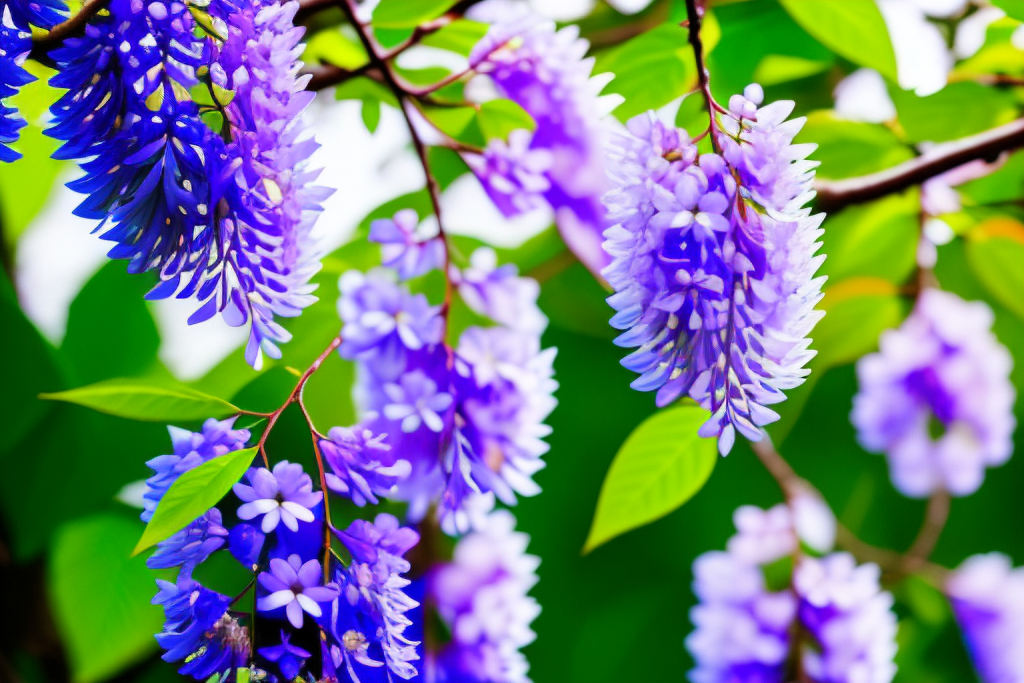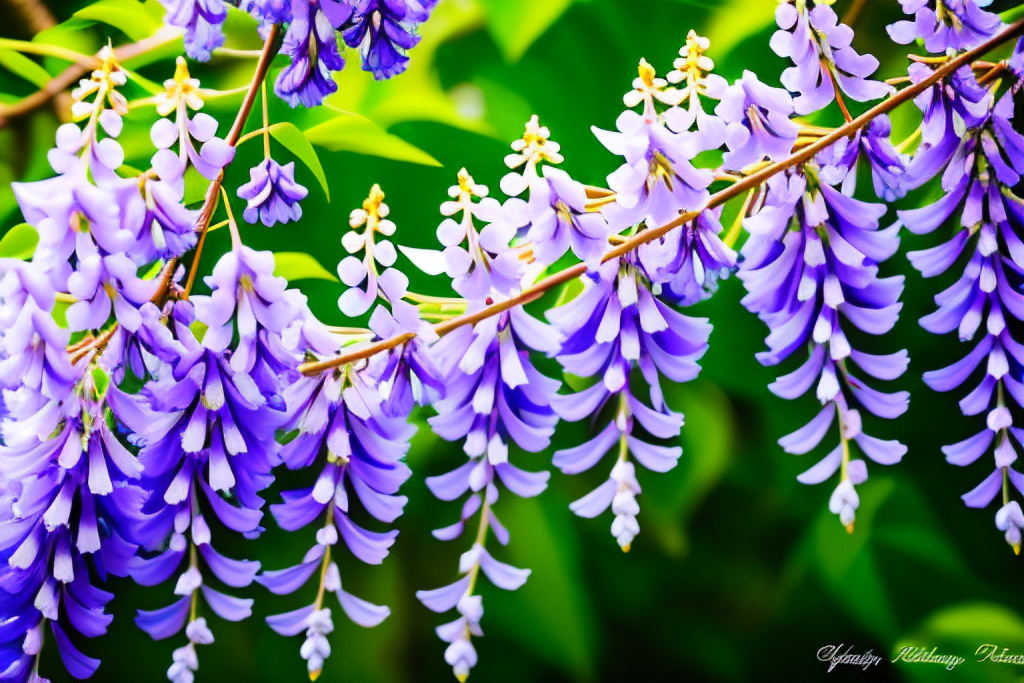Welcome to the enchanting world of Blue Moon Wisteria, a celestial delight that will elevate your garden to new heights of beauty and allure. This stunning flowering vine possesses a captivating charm that will transform your outdoor space into a paradise of celestial wonder.
Blue Moon Wisteria, also known as Wisteria macrostachya ‘Blue Moon,’ is a breathtaking vine that boasts clusters of fragrant, lavender-blue flowers. Its cascading blooms create a mesmerizing spectacle, reminiscent of a starry night sky. With its celestial beauty, this wisteria variety is sure to captivate the hearts of all who behold it.
Planting Blue Moon Wisteria in your garden is like adding a touch of magic. This celestial vine thrives in full sun to partial shade, and its vigorous growth habit ensures a bountiful display of blossoms. To cultivate the celestial paradise of your dreams, provide well-drained soil and ample space for this vine to spread its celestial wings.
Once established, Blue Moon Wisteria requires minimal care, making it an ideal choice for both experienced gardeners and novices alike. With proper pruning and training techniques, you can shape and control the growth of this vine, ensuring a healthy and vibrant display of blossoms year after year.
So, embark on a celestial journey and let Blue Moon Wisteria weave its magic in your garden. Prepare to be enchanted by its celestial beauty and the heavenly ambiance it brings to your outdoor sanctuary. With Blue Moon Wisteria, your garden will become a celestial paradise that will leave you and your guests in awe.
Growing Blue Moon Wisteria

Growing Blue Moon Wisteria can be a rewarding and enchanting experience for any gardener. With the right knowledge and care, you can cultivate a thriving vine that will adorn your garden with its stunning blue blossoms. Here are some essential tips and tricks to help you successfully grow Blue Moon Wisteria in your own backyard.
First and foremost, choosing the ideal planting conditions is crucial for the health and growth of your Blue Moon Wisteria. This vine thrives in full sun, so make sure to select a location that receives at least six hours of direct sunlight per day. Additionally, Blue Moon Wisteria prefers well-draining soil with a slightly acidic pH level. Before planting, it’s a good idea to amend the soil with organic matter to improve its fertility and drainage.
When it comes to planting, dig a hole that is twice as wide and deep as the root ball of your Blue Moon Wisteria. Gently remove the plant from its container and place it in the hole, making sure that the top of the root ball is level with the soil surface. Backfill the hole with soil, firming it gently around the roots. Water thoroughly after planting to settle the soil and promote root establishment.
Proper care techniques are essential for the growth and development of Blue Moon Wisteria. Regular watering is important, especially during dry spells or hot summer months. However, be cautious not to overwater, as this can lead to root rot. Mulching around the base of the plant can help conserve moisture and regulate soil temperature.
Furthermore, providing support for your Blue Moon Wisteria is crucial for its vertical growth. This vine is a vigorous climber and will benefit from the use of arbors, trellises, or other structures. Train the vines to climb and twine around the support system, ensuring that they have enough space to spread and grow.
In conclusion, growing Blue Moon Wisteria requires attention to detail and proper care techniques. By providing the ideal planting conditions, regular watering, and proper support, you can enjoy the beauty and allure of this celestial vine in your own garden.
Pruning and Training Techniques
Pruning and training techniques play a crucial role in shaping and controlling the growth of Blue Moon Wisteria. By utilizing these techniques effectively, you can ensure that your plant thrives and produces a stunning display of blossoms. Let’s explore some of the essential pruning and training techniques that will help you achieve a healthy and vibrant Blue Moon Wisteria in your garden.
When it comes to pruning, one important technique is to remove any dead or damaged branches. This not only improves the overall appearance of the plant but also promotes new growth. Additionally, pruning can be done to control the size and shape of the wisteria, preventing it from becoming too unruly or overwhelming in your garden.
Another technique is known as “heading back.” This involves cutting back the long, trailing branches to encourage lateral growth and more compact foliage. By doing so, you can create a denser and more visually appealing plant.
Training is equally important in shaping the growth of your Blue Moon Wisteria. You can guide the vines to climb and flourish on arbors and trellises, creating a breathtaking focal point in your outdoor space. By gently tying the vines to the support structure, you can encourage vertical growth and enhance the overall aesthetic appeal of your garden.
It’s also essential to regularly monitor and adjust the training as the wisteria grows. This ensures that the plant remains properly supported and prevents it from becoming tangled or overcrowded.
In summary, pruning and training techniques are vital for shaping and controlling the growth of Blue Moon Wisteria. By implementing these techniques, you can create a healthy and vibrant plant that will dazzle with its beautiful blossoms.
Training on Arbors and Trellises

Training your Blue Moon Wisteria to climb and flourish on arbors and trellises can create a breathtaking focal point in your outdoor space. This technique not only enhances the beauty of the plant but also maximizes its growth potential. Here are some essential tips to help you successfully train your Blue Moon Wisteria:
- Choose a sturdy support: When selecting an arbor or trellis, opt for a strong and durable structure that can withstand the weight of the vine as it grows.
- Positioning: Place the arbor or trellis in a location that receives ample sunlight, as Blue Moon Wisteria thrives in full sun.
- Start early: Begin training the vine when it is young and flexible, as it will be easier to manipulate and shape.
- Secure the main stem: Gently guide the main stem of the Blue Moon Wisteria towards the support structure and secure it using soft ties or twine. This will encourage the vine to climb.
- Encourage lateral growth: As the vine grows, train the lateral branches to spread out along the arbor or trellis, creating a lush and full display of blossoms.
- Regular pruning: To maintain the desired shape and prevent overcrowding, regularly prune any excessive growth and remove any dead or damaged branches.
By following these training techniques, you can transform your Blue Moon Wisteria into a stunning focal point that adds a touch of celestial beauty to your garden.
Pruning for Optimal Flowering
Pruning plays a crucial role in promoting optimal flowering and maintaining the overall health and vigor of your Blue Moon Wisteria. By following the best practices for pruning, you can ensure that your vine produces abundant blooms and remains in peak condition.
Here are some key tips to keep in mind when pruning your Blue Moon Wisteria:
- Timing: Prune your wisteria during the dormant season, typically in late winter or early spring. This allows the plant to focus its energy on new growth and flowering.
- Remove Dead or Diseased Wood: Start by removing any dead, damaged, or diseased branches. This helps maintain the plant’s overall health and prevents the spread of diseases.
- Encourage Air Circulation: Thin out the interior branches to improve air circulation and reduce the risk of fungal infections. This also allows more sunlight to reach the lower parts of the plant, promoting better flowering.
- Control Growth: Trim back long, unruly branches to control the size and shape of your Blue Moon Wisteria. This helps prevent overcrowding and ensures a well-balanced and visually appealing appearance.
- Prune After Flowering: Once your wisteria has finished blooming, remove any spent flowers and trim back the long, trailing shoots. This encourages the development of new flower buds for the next season.
Remember to use sharp and clean pruning tools to make clean cuts and minimize the risk of infection. Regular pruning will not only enhance the beauty of your Blue Moon Wisteria but also promote its overall health and vitality, allowing you to enjoy a stunning display of blossoms year after year.
Controlling Growth and Preventing Overcrowding
Controlling the growth of your Blue Moon Wisteria is essential to prevent overcrowding and maintain a well-balanced and visually appealing garden. By implementing effective strategies, you can ensure that your wisteria thrives without taking over your entire outdoor space.
One method of controlling growth is through regular pruning. By selectively removing excess branches and foliage, you can promote better air circulation and prevent overcrowding. This will not only maintain the overall health of your wisteria but also encourage more abundant flowering.
Another technique is to provide proper support for your wisteria. By training it to grow on a trellis or arbor, you can guide its growth in a controlled manner. This will prevent the plant from spreading too far and keep it confined to a specific area, preventing overcrowding.
Additionally, you can use root barriers to control the growth of your wisteria. These barriers can be installed underground to prevent the plant’s roots from spreading too far and taking over other areas of your garden.
Regular monitoring and maintenance are also crucial in controlling growth. Keep an eye on your wisteria and promptly remove any new shoots or runners that appear outside of the desired area. This will help maintain a well-balanced and visually appealing garden.
In conclusion, controlling the growth of your Blue Moon Wisteria is essential to prevent overcrowding and maintain a balanced garden. Through regular pruning, providing proper support, using root barriers, and monitoring the plant’s growth, you can ensure that your wisteria thrives while maintaining the overall aesthetics of your outdoor space.
Pruning in Containers
When it comes to growing Blue Moon Wisteria in containers, there are a few important considerations and techniques to keep in mind. Pruning plays a crucial role in maintaining a compact and manageable growth habit for your wisteria plant.
Considerations:
- Choose a container that is large enough to accommodate the root system of your Blue Moon Wisteria.
- Ensure the container has good drainage to prevent waterlogging, which can lead to root rot.
- Place the container in a location that receives at least six hours of sunlight per day.
Pruning Techniques:
Regular pruning is essential to control the size and shape of your Blue Moon Wisteria when grown in containers. Here are some techniques to help you achieve a compact growth habit:
1. Prune in late winter or early spring: This is the best time to prune your wisteria, as it is dormant and before new growth begins. Remove any dead or damaged branches, as well as any unwanted or crossing branches.
2. Maintain a framework: Train your wisteria to grow on a support structure, such as a trellis or stake, to create a desired shape. Regularly prune to maintain this framework and remove any excessive growth.
3. Control the length of shoots: Trim back long shoots to encourage branching and a bushier growth habit. This will help prevent your wisteria from becoming leggy and unruly.
4. Remove spent flowers: After your Blue Moon Wisteria has finished blooming, prune off the spent flowers. This will redirect the plant’s energy towards new growth and promote a healthier plant overall.
By following these unique considerations and pruning techniques, you can ensure that your Blue Moon Wisteria thrives in containers, providing you with a beautiful and manageable growth habit.
Pest and Disease Management
Pest and disease management is crucial for maintaining the health and vitality of your Blue Moon Wisteria. By being aware of the common pests and diseases that can affect this stunning flowering vine, you can take proactive measures to prevent and treat these issues, ensuring a thriving plant in your garden.
Common pests that may target Blue Moon Wisteria include aphids and spider mites. These tiny creatures can wreak havoc on your plant by sucking sap from the leaves and causing damage. To prevent infestations, regularly inspect your wisteria for signs of pests and take immediate action if you spot any. You can use insecticidal soaps or neem oil to control aphids and spider mites effectively.
Another potential threat to Blue Moon Wisteria is powdery mildew, a fungal disease that can cause a white powdery coating on the leaves. To prevent powdery mildew, ensure good air circulation around your plant and avoid overwatering. If powdery mildew does occur, you can use fungicides specifically formulated for this disease to treat the affected areas.
Root rot is another concern for Blue Moon Wisteria. This disease is caused by overly wet soil conditions and can lead to the decay of the plant’s roots. To prevent root rot, ensure that your wisteria is planted in well-draining soil and avoid overwatering. If you notice signs of root rot, such as yellowing leaves and stunted growth, it is essential to take immediate action by improving drainage and treating the affected roots with a fungicide.
By understanding the pests and diseases that can affect Blue Moon Wisteria and implementing effective prevention and treatment strategies, you can ensure the long-term health and beauty of this celestial delight in your garden.
Identifying and Treating Common Pests

One of the key aspects of maintaining a healthy Blue Moon Wisteria is identifying and treating common pests that can infest the plant. By being proactive in pest management, you can ensure the vitality and longevity of your beautiful vine. Two common pests that can affect Blue Moon Wisteria are aphids and spider mites.
Aphids:
Aphids are small, soft-bodied insects that feed on the sap of plants. They can cause damage by sucking the plant’s juices and leaving behind a sticky residue known as honeydew. To identify aphids on your Blue Moon Wisteria, look for clusters of tiny, pear-shaped insects on the undersides of leaves or along the stems. They can be green, black, or brown in color.
| Identification | Treatment |
|---|---|
| Clusters of tiny, pear-shaped insects on undersides of leaves or along stems | – Spray the affected areas with a strong stream of water to dislodge the aphids – Introduce natural predators, such as ladybugs or lacewings, to control the aphid population – Use insecticidal soap or neem oil as a last resort |
Spider Mites:
Spider mites are tiny arachnids that can cause damage to Blue Moon Wisteria by piercing the plant’s cells and sucking out their contents. They are often found on the undersides of leaves and can cause discoloration and webbing. To identify spider mites on your Wisteria, look for tiny, speck-like creatures and fine webbing.
| Identification | Treatment |
|---|---|
| Tiny, speck-like creatures and fine webbing on undersides of leaves | – Spray the affected areas with water to reduce the population of spider mites – Introduce predatory mites or ladybugs to control the infestation – Apply insecticidal soap or neem oil to eliminate spider mites |
By promptly identifying and treating common pests like aphids and spider mites, you can keep your Blue Moon Wisteria healthy and pest-free. Regular monitoring and proactive measures will help ensure that your plant thrives and continues to grace your garden with its celestial beauty.
Preventing and Managing Diseases
Preventing and managing diseases is crucial for maintaining the health and vitality of your Blue Moon Wisteria. Two common diseases that can affect this stunning flowering vine are powdery mildew and root rot. By taking proactive measures, you can ensure the longevity and beauty of your plant.
Powdery mildew is a fungal disease that often appears as a white, powdery coating on the leaves, stems, and flowers of Blue Moon Wisteria. To prevent powdery mildew, make sure to provide adequate air circulation around the plant by spacing them properly and avoiding overcrowding. Regularly inspect your plant for any signs of mildew and take immediate action if detected.
Root rot, on the other hand, is caused by overly wet soil conditions, which can lead to the decay of the plant’s roots. To prevent root rot, ensure that your Blue Moon Wisteria is planted in well-draining soil and avoid overwatering. It’s essential to allow the soil to dry out slightly between waterings to prevent excessive moisture accumulation.
If you notice any signs of root rot, such as yellowing leaves or wilting, take action immediately. Remove the affected parts of the plant and adjust your watering practices to prevent further damage. Additionally, consider using a fungicide specifically formulated for treating root rot to effectively manage the disease.
Regularly inspecting your Blue Moon Wisteria for signs of diseases, such as powdery mildew and root rot, and taking proactive measures to prevent and manage them will ensure the longevity and vitality of your plant. By maintaining a healthy growing environment and promptly addressing any issues, you can enjoy the celestial beauty of your Blue Moon Wisteria for years to come.

